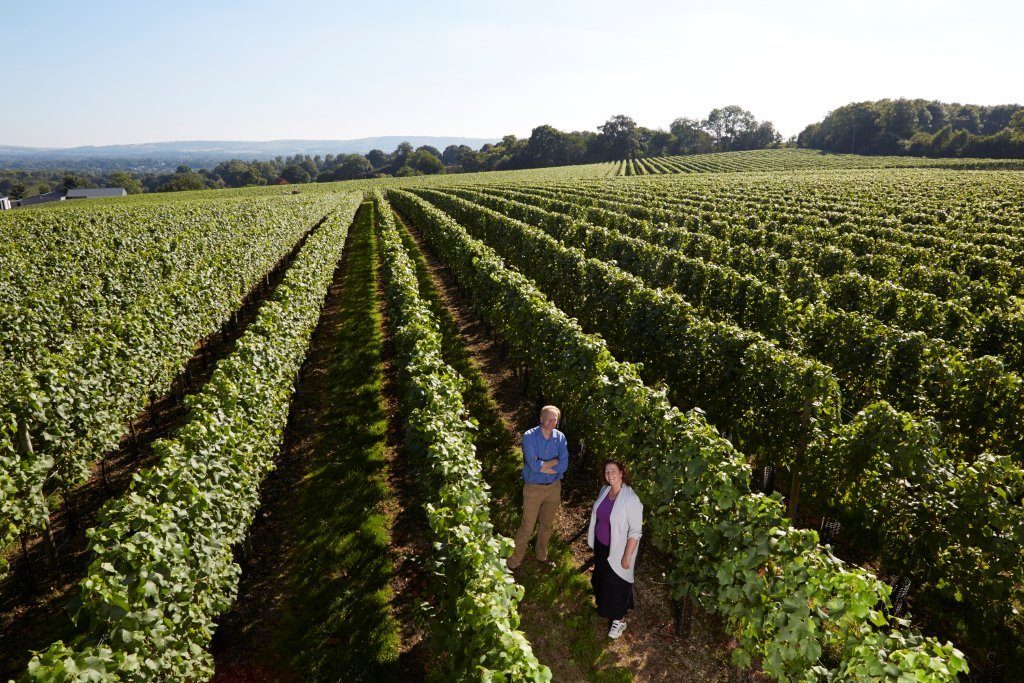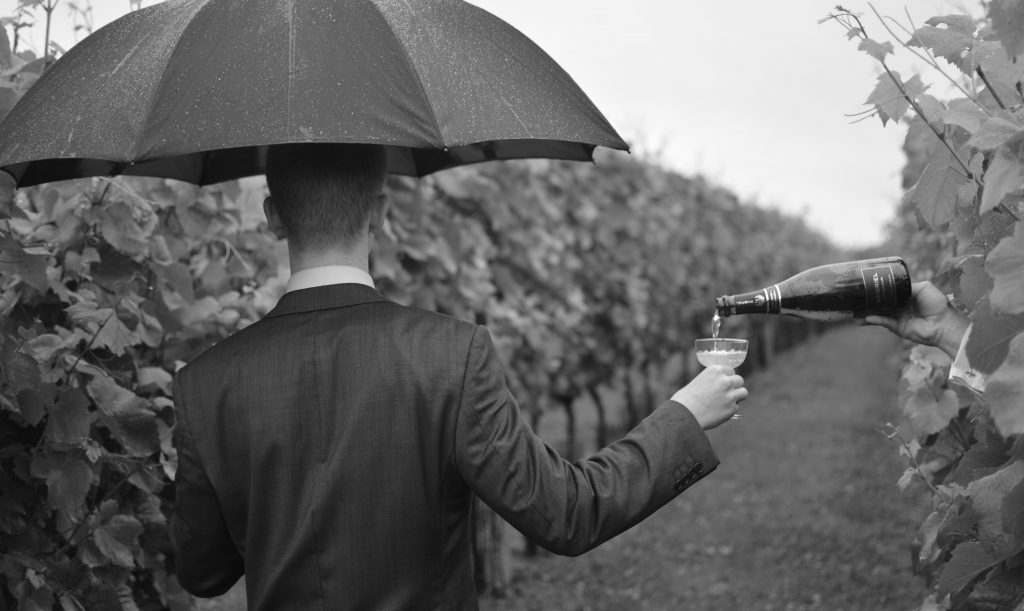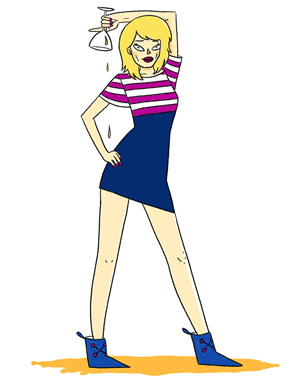
“English wine can be rampantly acidic,” admits Charles Outhwaite who makes sparkling wine in West Sussex. How fortunate that assertive acidity forms the backbone of traditional method sparking wine and these days English fizz is riding a wave of popularity. Our marginal winemaking climate, cool and rather wet, is not unlike Champagne. Nyetimber Vineyard blazed a trail, showing that we can do sparkling wine quite as well as the Champenois. Ambriel follows in their wake.
When QC Wendy Outhwaite tasted a glass of Nyetimber she was smitten and in 2006 the Outhwaites began searching for their slice of sparking terroir. Two years later they found a farm near the hamlet of Nutbourne in West Sussex The 9.5 hectares of vines form a tidy chapeau on a greensand mound. The mound bears the hall mark of Iron Age earthworks and the vines benefit from a south facing slope. This sunny aspect is vital to keep that rampant acidity in check and ensure the grapes ripen.
Wendy was drawn to the greensand rock. “It drains well – reflects and retains the heat.” she says. “I think it’s better than chalk.” Fighting talk. I had yet to taste the wine…
Wendy is a self confessed control freak. No bad thing in a winemaker. The vineyard is planted in Chardonnay and Pinot Noir with a small parcel of Pinot Meunier (6%), i.e. the trad. Champenois trio, except that Wendy didn’t want Champenois vines. She held out for Burgundian clones and each clone is grafted on different rootstock and vinified separately. As a bit of a clone nerd myself… all due respect for this meticulous approach.
In the squeaky clean winery German kit is clearly preferred. The wines are fermented in stainless steel with no malolatic. However a little Chardonnay is fermented in four year old Burgundy barrels to add some texture. The base wines are tasted blind to make the blend. “We make the best blend we can. We don’t assess what we have and make the blends accordingly. It’s not very economic,” she laughs ruefully. In classic fashion the blended, bottled wines go through a second fermentation to create a fine mousse and are left for 3 to 5 years to quietly get on with the autolytic process. The magic happens as the yeast cells create a biscuity complexity before being expelled.
2010 was the first vintage. Wendy and Charles didn’t finish harvesting until Guy Fawkes night and wondered what they had let themselves in for. “It’s not uncommon to finish the harvest in November,” says Charles. “It’s a balancing act. You have to wait as long as possible for the grapes to ripen and decrease in acidity before botrytis sets in.” In 2012 the weather was so poor, Chardonnay didn’t make it.
The 2010 wine was left on lees for 3 years. “The malic is always quite high and green,” says Charles. “We prefer to keep the wine for 5 years on lees now. And you need to age them under cork too.” They don’t use too much dosage here – 6 to 8g/l – a good thing in my book. They rely the rich leesy characters from long ageing to balance the high acidity.
The Classic Cuvée is non-vintage, except that it’s not. The Classic Cuvée and Blanc de Blanc (current release) are solely from 2010, but as Wendy and Charles have put aside wine from this and subsequent vintages, the NV into the future will be blend.
It’s worth mentioning that Non-Vintage sparking wine is a blend of current and reserve stock which allows a house style to be produced regardless of vintage variation, hitting a consistent level of quality and complexity…well that’s the theory. In Champagne exceptional vintages are declared i.e. a wine made from that vintage alone and labelled as such. Wendy and Charles will do this too, but we’re getting ahead of ourselves here. Making traditional method sparkling wine is not for those in a hurry.

Let’s get on to the wines. Well, suffice to say, the nose was impressed… and this from young vines and no prior winemaking experience. The rosé is a fun fizz. With its higher dosage, it is glug-able and somewhat wanton, but the Classic Cuvée and Blanc de Blanc do not bestow their favours so readily. They are more reserved in a style befitting our cool climate. These are wines of backbone, firm acidity and grip.
Ambriel, Classic Cuvée
This blend of Chardonnay, Pinot Noir and a dash of Pinot Meunier has an inviting aroma of toasted hazelnuts and the first sensation on the palate is of freshly baked bread. It moves to a straight edged, citrus palate with a firm, lime-zest core. Good intensity and a zingy, fresh finish. This is drinking very well now. £27.50 (£25 for 6 or more)
Ambriel, Classic Cuvée
This is effectively a wine from 2011, which was warmer than 2010. A poor flowering allowed the vines to concentrate effort on ripening a smaller crop. This had 5 years on lees. A little closed to start with, especially on the nose, but the palate opens up. Here the biscuit note is more buttery. A somewhat rounder, fuller, more muscular palate. Good density in the middle. There is a certain grip here; a darker and more powerful finish. It would benefit from a bit more bottle age, which is fine as it will not be released until after the wine above has been sold.
Ambriel, Blanc de Blanc
This is focused, pure and zesty. It has a keen lemony line through the palate to a fine finish. There is a hint of elderflower. An intense, taut wine – both firm and delicate. This is the most refined of Ambriel’s wines and comes from one block of Chardonnay which always tends to ripen well. It is reserved at the moment and needs more time in bottle to unfurl its lacy complexity. Keep an eye on the website as this has not yet been released.
Ambriel, Rosé
Pretty pale pink colour. An inviting aroma of summer fruits – ripe redcurrant and wild strawberries. This has a higher dosage. It is sweet and juicy – the acidity and sweetness combine to make it all too slurp-able. There are lovely bursts of redcurrant fruit on the palate. It is the most straightforward of Ambriel’s wines, but none the worse for that. You could happily serve this with a fruit-based pudding, provided it was not too sweet, or it would make make a palate engaging combo with something savoury and salty. £27.50 (or 25 for 6 bottles)
The wines can be purchased from Ambriel directly (on line or pop into Redfold Vineyards, Nutbourne Lane, Nutbourne nr Pulborough West Sussex RH20 2HS) or from Private Cellar
Charles shows off his ‘sabrage’ skills in the film below – great party trick if you can master it!

